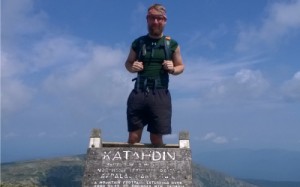 A local man recently joined the ranks of a small percentage of hikers who have completed the legendary Appalachian Trail in a single trip, earning him the designation of a true 2,000-miler in the process.
A local man recently joined the ranks of a small percentage of hikers who have completed the legendary Appalachian Trail in a single trip, earning him the designation of a true 2,000-miler in the process.
Ben Barrow, 25, hadn’t been much of a hiker or camper before watching a documentary about the Appalachian Trail on Netflix, but something about the trail appealed to Barrow’s sense of adventure and a desire to experience new things.
“The Appalachian Trail really interested me. I’d never really hiked before, maybe two or three times, but I like figuring things out. It can be just as much fun figuring out how something works as it is actually doing it,” surmised Barrow. “Researching the hike was just as much fun as actually doing it. I spent about a year-and-a-half just playing around with the thought, do I really want to do this?”
In considering what a hike such as the Appalachian Trail would entail, Barrow had to decide if he wanted to hike the trial in sections over the course of several years, as many often choose to do, or did he want to go as a thru-hiker, attempting to complete the entire 2,180 miles of trail that spans 14 states in less than a year. Either way, he would be one of two to three million hikers who walk a portion of the trail each year.
Barrow’s research included going to local outdoor stores and comparing hiking equipment, considering things like if it was worth it to carry more or less weight in a pack. He took smaller, weekend hiking trips to get a feel for some of what he might experience.
“It’s all about weight,” said Barrow, who started his hike with about 45-pounds of weight on his back, but pared it down to right at 30 pounds, including food and water. “That was a good weight. You have to decide if you want to be more comfortable at camp or while you’re walking. I wanted to be comfortable walking, but at the same time I would not sacrifice the ability to take care of myself.”
“It takes a lot of practice to get comfortable on the trail,” said Barrow, admitting that a couple of times during his journey he considered quitting, but each time he was miles from any main roads or towns, so by the time he’d headed off the trail, it didn’t take long to reconsider and continue on.
“I quit the trail twice, but when you have five to 10 miles to hike out, you might as well keep going,” said Barrow.
Barrow started at the beginning of the Appalachian Trail at Springer Mountain in Georgia on March 9 of last year, with plans to head north to the halfway point and then jump ahead to the end of the trail and work his way back south. It is what those familiar with the Appalachian Trail and its many forms of hiking refer to as “flip-flopping,” where thru-hikers hike the entire trail in discontinuous sections to avoid crowds, extremes in weather or start on easier terrain.
On average, most thru-hikers finish the Appalachian Trail within about six months, but Barrow took a few months longer, finishing in nine months.
“Most finish in six months, but I took my time,” said Barrow, describing those who like himself who want to savor the experience and others whose main goals are to just finish the trail as a notch in their belts more so than a chance to shed the trappings and stresses of every day life and get closer to nature.
Barrow said he hiked eight to 10 hours a day, sometimes traveling with other groups of hikers, sometimes alone. On the trail he became known as “Socrates,” in line with the tradition of hikers earning nicknames during the trek. Whenever he deviated from the actual trail, which sometimes happened, Barrow always doubled back to complete a missed stretch.
Once in West Virginia, Barrow went from being a northbounder hiker to a southbounder. He took a train and bus to the trail’s end in Katahdin, Maine, then began hiking south. It was a way for Barrow to avoid some of the trail’s most crowded portions, as well as some of the worst weather.
Barrow said he was in the bubble with the majority of hikers heading north at the start of his hike, calling it a very social learning experience. It didn’t take long for him to be able to discern between day and weekend hikers to those like himself who were in it for the long haul. A whiff of laundry detergent emanating from someone’s clothing was a good way to tell the difference, he said.
As far as wildlife on the trail, Barrow saw a lot of it, but said it was a matter of reminding himself that he as a human was the most dangerous predator on the trail. One of the biggest challenges was one of the mind.
“You are alone with your thoughts,” said Barrow. “When you’re just out there walking, there’s a lack of stimulus and you think about anything because you’ve got 18 more miles to do for the day. It’s not you versus the mountain; it’s you versus yourself.”
During the nine-months Barrow was out on the trail, he took time to experience the experience, if you will, staying in small towns sometimes for a few days, other times longer. He spent two weeks in Damascus, Va., arriving just in time for Trail Days in May. Other times he would stay long enough to work for a few bucks when needed.
“It was more important for me to experience the trail than try to save it,” said Barrow when asked if he kept a journal during the trek. “It was my experience. I’d rather tell people about it.”
One of the things people tend to let go of on the trail is something all too familiar in today’s modern day life, where everyone is in a rush. Barrow said his biggest challenge was sometimes spending four or five days without seeing another person.
When he did see people, it was a social experience, and Barrow met people from all over the United States. I met people from Ohio, Oregon to Texas and Alaska and people from every state on the East Coast,” said Barrow.
Because Barrow said he chose early on that he wanted to experience the Appalachian Trail rather than just hike it, Barrow said he embraced the chance to leave the trail from time to time to see a waterfall or visit an obscure American town.
“I liked seeing the towns. In every state, every town had a story all up and down the East Coast,” said Barrow, who noted that the smaller the town, the better the people treated others.
What did he learn on the trail?
Barrow said he learned to respect people more.
“A little respect goes a mile,” he said.
He also learned a lot about nature, Her different seasons and Her different colors. Now, it’s all there in his memory and on his camera. He even went to bed one night expecting a mild hike the next day only to wake up to a foot of snow on the ground.
And he learned that with a little power cord, duct tape and a knife, you can make just about anything. One trail friend even fixed his shoes with a piece of dental floss after he ripped the top open.
“You just have to figure it out,” he said.
Barrow finished his hike shortly after Thanksgiving. It was then that he received his 2,000 miler patch.
“This is what I worked so hard for,” said Barrow as he took out the small, half-moon shaped patched, stored in a plastic bag with dozens of others from different sections of the Appalachian Trail.
Barrow said he would recommend the trip to others, definitely.
“I tell anybody that can do it, if they can, do it,” said Barrow.
What’s next for Barrow in his quest for adventure and figuring things out? He thinks he might like to traverse the Colorado or Mississippi rivers or a couple of rivers in Canada. There’s also the Pacific Crest Trail on the west coast or he might try his hand at living on a sailboat for a couple years and learning how to sail across the world.
“The unknown is the most fun,” said Barrow.









